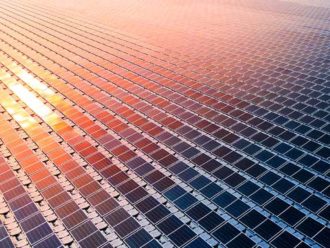The pathways to reaching net zero are many, and while slashing fossil fuel based energy-related emissions remains the largest addressable area, moving towards a circular economy is inextricably intertwined with this endeavour and has a pivotal role to play in reducing global emissions.
“The earth that we live on does not have inexhaustible resources that are going to be available forever – we are depleting our natural resources and fast,” reflects Randeep Somel, manager of the M&G Climate Solutions Strategy.
“We are using up our resources of arable land, fresh water and vital minerals – including those that are needed for green infrastructure such as nickel and cobalt, therefore it is in everyone’s interest to keep these systems going through a closed loop system which means we design out waste as much as we can by constantly reusing the resources we have already extracted. We need to do this before scarcity and emissions become even bigger issues.”
“Regulation, education and incentivisation go hand-in-hand to foster wholesale change in the right direction.”
Currently, circularity on the vast sphere that we call our planet stands at 8.6%, according to the Circularity Gap Report 2022[1], and doubling this globally could reduce global emissions by 39% as well as slashing total material footprint by 28% by 2032.
So, without the need to ostensibly create anything new, how can investors ensure that everything in the system stays for as long as it can and be used more efficiently? Here are three ways to help decouple economic growth and natural resource consumption while driving greater competitiveness in what is a limited window of opportunity to move towards and operate within a 1.5-degree heated world by the year 2100.
1. Incentivising behavioural change through regulation
Regulation, education and incentivisation go hand-in-hand to foster wholesale change in the right direction – particularly amongst individuals who will need to change their daily patterns of behaviour and consumption to help reduce waste and emissions.
In 2015, the UK government introduced a 5 pence charge on plastic carrier bags in England in order to tackle plastic pollution. “Lo and behold the purchase of those bags fell by 95% – now that’s incentivisation,” says Somel. When contextualised at an individual level, the average household has slashed its consumption of single-use plastic bags from 140 per year pre-2015 to just four today[2].
Going a step further, last year the UK government increased the charge on plastic bags in England to 10 pence, extended it to all retailers and anticipates the use of single-use plastic bags to decrease by 70%-80% among small and medium-sized businesses.
“We need to reduce the amount of waste that an organisation, a country, or an individual produces and say: ‘This is neither acceptable or necessary, and lets find a way to price for all the externalities caused.’ So you have a disincentive, effectively, and at the same time you need to incentivise the companies that do use that closed-loop method over that linear method,” adds Somel.
2. New technologies closing the loop
New technologies bring the opportunity to take a previously linear – and therefore, wasteful – model and close the loop, boosted by incentivisation and regulation.
For example, in 2020 the UK government announced[3] that the sale of new internal combustion engine vehicles will be illegal from 2030 and hybrids from 2035 (regulation) with grants available for homeowners, businesses and local authorities to install charging points (incentivisation). But in addition to incentivisation and regulation, how is the manufacturing process of these vehicles integrating circularity into the design process to ensure minimal waste?
“Electric cars are now being built to ensure that the supply chain is carbon neutral and components recyclable,” says Somel. “There is an obligation that at the end of its life, the battery in an electric car has to be recycled and we can do this as with relatively new supply chains and product chains we can ensure we only engineer in materials that have these properties.”
“This can not necessarily be said for older products in the economic system today as the environmental onus was never there when the products were originally engineered. Now that we have more sustainable products i.e. electric cars because they help reduce emissions, let’s make sure we build in the circular economy element as well.”
“Speaking to the larger car manufacturers they will openly share that: ‘We have to do this now because it’s what our customers want, and at the same time this also improves the cost comparativeness between electric and combustion vehicles. Having more recyclable parts at the end of life will also incentivise the close loop system, as there are economic as well as environmental reasons to recycle.”
3. Removing waste from our diet
Our relationship with food is complex, often wasteful and both resource and carbon-intensive. According to a study by Nature Food[4], 57% of global greenhouse gas emissions from the production of food corresponds to the production of animal-based food, including livestock feed. While behaviours are changing – daily meat consumption in the UK has dropped by 17% between 2008-2019[5] – we still need solutions to take as much waste as possible out of the system.
In order to help combat waste, M&G’s Climate Solutions team invests in US-listed Darling Ingredients, which transforms waste products into feed and fuel. This ensures that the carbon from meat by-products is captured and reused rather than left to rot and release further greenhouse gas emissions while decomposing, which serves no purpose.
“Darling Ingredients has 124,000 unique pick-up points across the US where they pick up waste meat carcasses, recycle and then convert them into bio-based fuels so they can be redeployed in a way that helps us reduce emissions,” says Somel. “It takes a lot of waste out of the system that would otherwise decompose, and it substitutes for a product that is far more carbon emitting.
“The key with circular is that it’s in every area, and the potential remains very large” Somel reflects.





